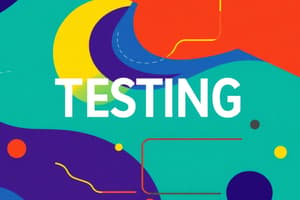Podcast
Questions and Answers
What is a key benefit of collaboration between testers and developers?
What is a key benefit of collaboration between testers and developers?
- Enhanced understanding of code and requirements leads to better test creation. (correct)
- Testers can create production code with developer insights.
- Developers can work independently without outside input.
- Testers handle all test data creation without developer involvement.
Which activity is essential for minimizing issues during integration and acceptance testing?
Which activity is essential for minimizing issues during integration and acceptance testing?
- Conducting tests in isolation without collaboration.
- Only developers writing all tests without input from testers.
- Testers should avoid understanding the code.
- Regular discussions between developers and testers. (correct)
How can testers assist developers in the testing process?
How can testers assist developers in the testing process?
- By writing documentation for all code changes.
- By creating test data and expected outcomes. (correct)
- By minimizing involvement in automation testing efforts.
- By coding the entire application independently.
What is the ultimate goal of collaboration between testers and developers?
What is the ultimate goal of collaboration between testers and developers?
Why is it important for developers and testers to communicate effectively?
Why is it important for developers and testers to communicate effectively?
What is the primary focus of component testing?
What is the primary focus of component testing?
Which of the following is a goal of component testing?
Which of the following is a goal of component testing?
What is one drawback of component testing?
What is one drawback of component testing?
Why might developers avoid fully testing their own code?
Why might developers avoid fully testing their own code?
What is a benefit of using automated testing frameworks in component testing?
What is a benefit of using automated testing frameworks in component testing?
What technique can developers use to isolate components during testing?
What technique can developers use to isolate components during testing?
Subsystem testing is typically characterized by which of the following?
Subsystem testing is typically characterized by which of the following?
What is a potential issue when testing components with complex interfaces?
What is a potential issue when testing components with complex interfaces?
Flashcards
Collaborative Component Testing
Collaborative Component Testing
Developers and testers collaborating to write automated tests that verify individual parts of the system.
Tester and Developer Roles in Component Testing
Tester and Developer Roles in Component Testing
Testers help developers create realistic data and expected outputs to test the system's functionality, while developers assist testers in testing individual subsystems and writing automated scripts.
Benefits of Collaborative Component Testing
Benefits of Collaborative Component Testing
By combining perspectives and skills, testers and developers can identify potential issues earlier, reducing defects and improving software quality.
Importance of Communication in Component Testing
Importance of Communication in Component Testing
Signup and view all the flashcards
Shared Understanding in Component Testing
Shared Understanding in Component Testing
Signup and view all the flashcards
Component Testing
Component Testing
Signup and view all the flashcards
Components
Components
Signup and view all the flashcards
Mocking
Mocking
Signup and view all the flashcards
Early Bug Detection
Early Bug Detection
Signup and view all the flashcards
Code Coverage
Code Coverage
Signup and view all the flashcards
Subsystem Testing
Subsystem Testing
Signup and view all the flashcards
Cognitive Dissonance in Testing
Cognitive Dissonance in Testing
Signup and view all the flashcards
Component Testing Trade-offs
Component Testing Trade-offs
Signup and view all the flashcards
Study Notes
Component Testing
- Component testing is a crucial part of the software development lifecycle that focuses on the isolation and testing of individual code components. The objective of this practice is to ensure that each component independently functions correctly on its own, which is vital in preventing defects from propagating throughout the overall system.
- Components are defined as the smallest, independently testable units of code. This modular approach allows for testing specific functionalities without interference from other parts of the system, facilitating a more straightforward debugging process and improving code quality.
- The primary goal of component testing extends beyond merely checking functionality; it also involves verifying that the component operates according to its specifications. Additionally, it ensures that every line of code is executed at least once during testing, which helps in identifying any potential issues or bugs that need to be addressed.
- This testing paradigm is primarily the responsibility of developers, which necessitates an in-depth understanding of the codebase. A strong grasp of the code's architecture and logic is essential for developers to effectively create and execute thorough test cases.
- To facilitate the testing process, developers often leverage automated frameworks such as JUnit, NUnit, and PyTest. These tools not only help in the execution of tests but also in evaluating the outcomes of the tests and generating reports that provide insights into the testing process and its effectiveness.
- Mocking techniques are particularly valuable in component testing as they enable the isolation of components by simulating interactions with external dependencies. By removing these dependencies, developers can focus solely on the functionality of the component being tested, leading to more accurate and reliable test outcomes.
- In conjunction with mocking techniques, various tools and libraries are available that simulate interactions with the component under test. These mocking tools help to create controlled environments, which are essential for testing different scenarios without affecting real system components.
Benefits of Component Testing
- Early bug detection reduces later fix costs.
- Automated tests enable rapid code fixes and design improvements.
- Automated tests build confidence in refactoring and changes, ensuring code quality.
- Tests document component functionality, increasing clarity.
Limitations of Component Testing
- Only tests individual components, not integrations or external elements (databases, UI).
- Developers may not thoroughly test their own code due to cognitive biases and potential blind spots.
- Testing isolated components often increases code volume for auxiliary test code.
- Complex components need extensive testing, potentially requiring custom tools or libraries, adding cost and complexity.
Developer and Tester Collaboration
- Component testing often requires compromise, as developers may test integrated components (subsystems).
- Subsystem testing simplifies execution but makes design more complex.
- Subsystem testing leads to potentially lower code coverage and more difficult debugging due to testing interactions rather than individual code lines.
- Developers and testers can collaborate by jointly writing automated tests or by focusing on individual components.
- Testers can assist developers with test data and expected outcomes, developers can help testers with subsystem testing and automation.
- The shared goal is complete system functionality, achieving high-quality, comprehensive tests.
Achieving Effective Component Testing
- Collaborative developer-tester efforts are essential for reducing integration and acceptance testing issues.
- Divergent perspectives between developers and testers necessitate effective communication for success.
- Testers benefit from understanding the code, while developers benefit from understanding system requirements and expected outcomes.
Studying That Suits You
Use AI to generate personalized quizzes and flashcards to suit your learning preferences.




